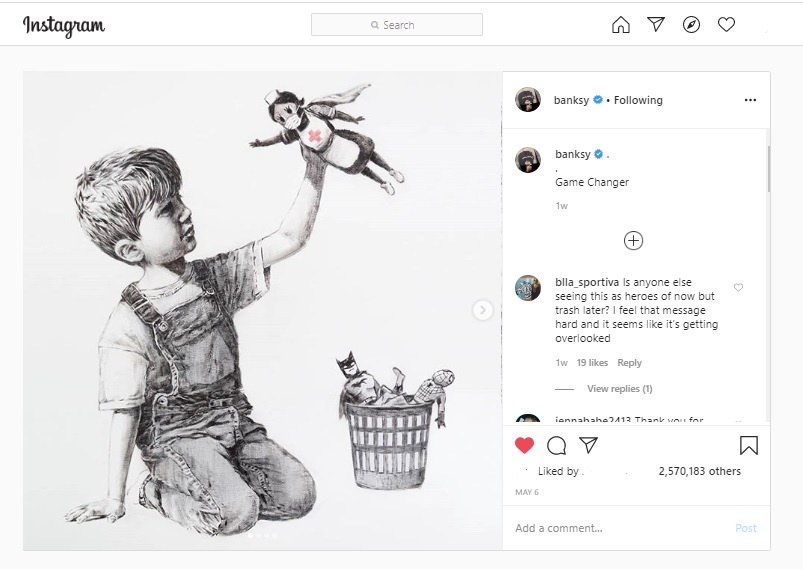‘Game Changer’, Banksy
Banksy posted his artwork that portrays a boy kneeling and holding a nurse-superhero character on his Instagram account @banksy, on May 6th, 2020. He wrote ‘Game Changer’ as a caption of this post. This artwork is one square meter painting that is displayed in Southampton Hospital, UK. Before this ‘New Superhero’ painting, he has created ‘a group of chaotic rat’ mural in his bathroom during the COVID-19 isolation.
Banksy is an anonymous street artist. He is well-known for his political public-artwork. He usually creates satirical street art in his giant graffiti and murals.
Banksy’s painting in Southampton Hospital illustrates a boy kneeling and playing his new game, the nurse wears a face mask and a cape-like superman. Beside the boy, the Batman and Spiderman characters look dumped into the wastepaper basket. This painting uses monochrome color, except for the red cross in the nurse’s apron.
The inspiration for this artwork comes from the healthcare workers’ hard work during the COVID-19 pandemic. It is impressed in Banksy’s note under the painting: “Thanks for all you’re doing. I hope this brightens the place up a bit, even if its only black and white.”
This artwork is related to the sacrifice of ill and dead healthcare workers in the UK during this pandemic period. More than 100 NHS (National Health Security) staff and other healthcare workers in the UK have died, caused by contact with COVID-19 patients.
Banksy’s artwork raises social awareness on the value of healthcare work. The work of the nurse and other healthcare workers cannot be missed or undervalued. This artwork also gives moral support to all healthcare workers in the midst of their duty.
Street and Public Artwork
Street art and public artwork are usually used as a means of social issues commentary. According to Gill Saunders–a senior curator at the Victoria and Albert Museum London, the principle of street art is “the reclamation of public space ‘for the people’ ”. Its root can be found in the 1960’s social activism that includes the civil rights movements, anti-Vietnam war movement, the student’s movement, the women’s movement, etc. The street artwork echoes the impact and energy of the 1960’s protest posters. The protesters used a poster that is produced in basic screenprint techniques on a cheap newsprint paper. These posters become a model for other demonstrations from Prague Spring to the American Anti-war protest. Inspired by the May 1968 Paris protest, some British social-activist, workers, anti-apartheid groups, and civil rights activist used posters in the same method.
Nowadays, some street artists, like Banksy and Shepard Fairey, do not only paint murals on a real wall but also post artwork on their social media virtual wall. The street artists use virtual walls to amplify the effect of their real artwork to all over the world. They use virtual walls to make wider public criticism and enjoyment. Walter Benjamin says in The Work of Art in the Age of Mechanical Reproduction (1935) is still relevant in this case: “The technological reproducibility of the artwork changes the relation of the masses to art”, from private/narrow art appreciation to the wider public sphere of life.
